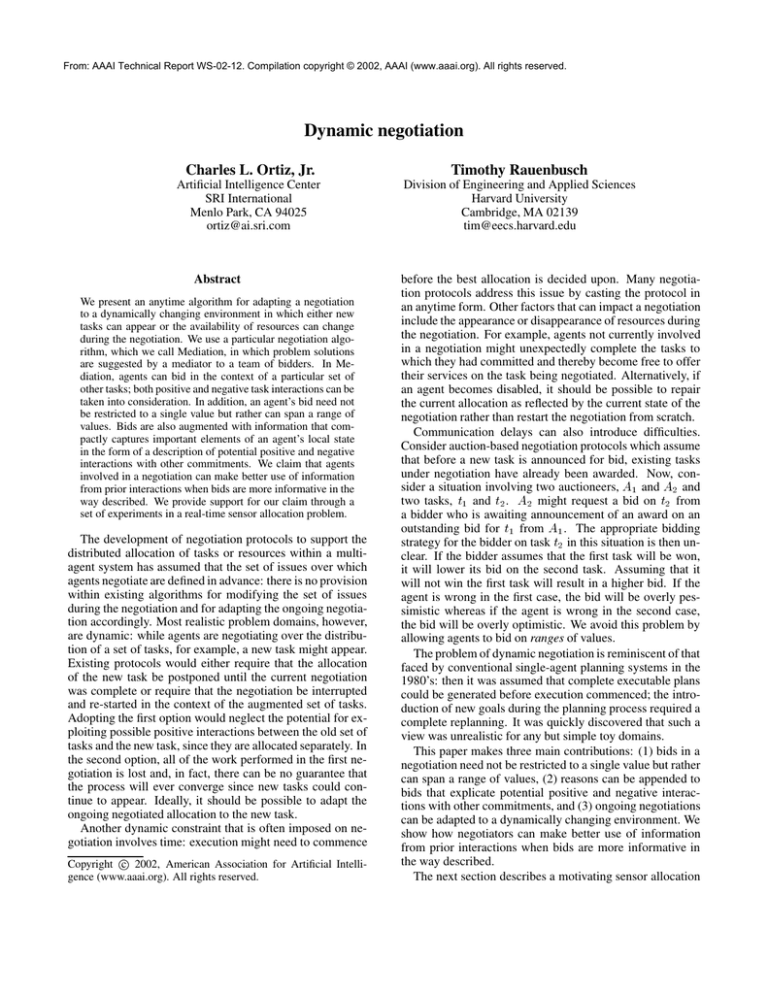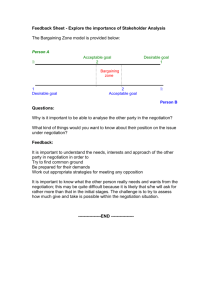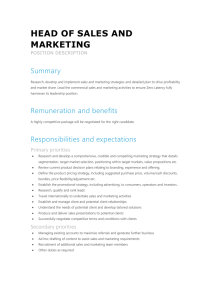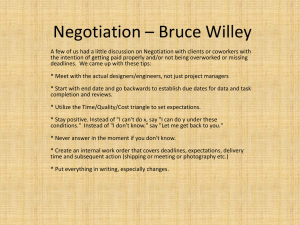
From: AAAI Technical Report WS-02-12. Compilation copyright © 2002, AAAI (www.aaai.org). All rights reserved.
Dynamic negotiation
Charles L. Ortiz, Jr.
Timothy Rauenbusch
Artificial Intelligence Center
SRI International
Menlo Park, CA 94025
ortiz@ai.sri.com
Division of Engineering and Applied Sciences
Harvard University
Cambridge, MA 02139
tim@eecs.harvard.edu
Abstract
We present an anytime algorithm for adapting a negotiation
to a dynamically changing environment in which either new
tasks can appear or the availability of resources can change
during the negotiation. We use a particular negotiation algorithm, which we call Mediation, in which problem solutions
are suggested by a mediator to a team of bidders. In Mediation, agents can bid in the context of a particular set of
other tasks; both positive and negative task interactions can be
taken into consideration. In addition, an agent’s bid need not
be restricted to a single value but rather can span a range of
values. Bids are also augmented with information that compactly captures important elements of an agent’s local state
in the form of a description of potential positive and negative
interactions with other commitments. We claim that agents
involved in a negotiation can make better use of information
from prior interactions when bids are more informative in the
way described. We provide support for our claim through a
set of experiments in a real-time sensor allocation problem.
The development of negotiation protocols to support the
distributed allocation of tasks or resources within a multiagent system has assumed that the set of issues over which
agents negotiate are defined in advance: there is no provision
within existing algorithms for modifying the set of issues
during the negotiation and for adapting the ongoing negotiation accordingly. Most realistic problem domains, however,
are dynamic: while agents are negotiating over the distribution of a set of tasks, for example, a new task might appear.
Existing protocols would either require that the allocation
of the new task be postponed until the current negotiation
was complete or require that the negotiation be interrupted
and re-started in the context of the augmented set of tasks.
Adopting the first option would neglect the potential for exploiting possible positive interactions between the old set of
tasks and the new task, since they are allocated separately. In
the second option, all of the work performed in the first negotiation is lost and, in fact, there can be no guarantee that
the process will ever converge since new tasks could continue to appear. Ideally, it should be possible to adapt the
ongoing negotiated allocation to the new task.
Another dynamic constraint that is often imposed on negotiation involves time: execution might need to commence
Copyright c 2002, American Association for Artificial Intelligence (www.aaai.org). All rights reserved.
before the best allocation is decided upon. Many negotiation protocols address this issue by casting the protocol in
an anytime form. Other factors that can impact a negotiation
include the appearance or disappearance of resources during
the negotiation. For example, agents not currently involved
in a negotiation might unexpectedly complete the tasks to
which they had committed and thereby become free to offer
their services on the task being negotiated. Alternatively, if
an agent becomes disabled, it should be possible to repair
the current allocation as reflected by the current state of the
negotiation rather than restart the negotiation from scratch.
Communication delays can also introduce difficulties.
Consider auction-based negotiation protocols which assume
that before a new task is announced for bid, existing tasks
under negotiation have already been awarded. Now, consider a situation involving two auctioneers, A1 and A2 and
two tasks, t1 and t2 . A2 might request a bid on t2 from
a bidder who is awaiting announcement of an award on an
outstanding bid for t1 from A1 . The appropriate bidding
strategy for the bidder on task t2 in this situation is then unclear. If the bidder assumes that the first task will be won,
it will lower its bid on the second task. Assuming that it
will not win the first task will result in a higher bid. If the
agent is wrong in the first case, the bid will be overly pessimistic whereas if the agent is wrong in the second case,
the bid will be overly optimistic. We avoid this problem by
allowing agents to bid on ranges of values.
The problem of dynamic negotiation is reminiscent of that
faced by conventional single-agent planning systems in the
1980’s: then it was assumed that complete executable plans
could be generated before execution commenced; the introduction of new goals during the planning process required a
complete replanning. It was quickly discovered that such a
view was unrealistic for any but simple toy domains.
This paper makes three main contributions: (1) bids in a
negotiation need not be restricted to a single value but rather
can span a range of values, (2) reasons can be appended to
bids that explicate potential positive and negative interactions with other commitments, and (3) ongoing negotiations
can be adapted to a dynamically changing environment. We
show how negotiators can make better use of information
from prior interactions when bids are more informative in
the way described.
The next section describes a motivating sensor allocation
T1
1
3
n1
2
1
n4
n2
T2
Dynamic Mediation
n3
4
2
3
3
n5
n6
n8
n9
2
4
n7
6
where i = j .
1
Figure 1: Multisensor tracking.
problem. We then describe a negotiation protocol called Mediation, in which a allocations are proposed to bidders, who
can then submit complex, informative bids. We then report
on experimental results and related work.
Motivating example
We have been investigating the issues surrounding the problem of dynamic negotiation in the context of a real time distributed resource allocation problem involving multisensor
tracking. An example is shown in Figure 1. The figure
depicts an array of nine doppler sensors. Each sensor has
three sectors associated with it, labeled 1 2 3 . A sensor
can turn on a sector and take both frequency and amplitude
measurements to determine velocity and distance. A sensor
can only have one sector on at a time, however. The farther away the target is from the sensor, the lower the quality
of the measurement. At least two sensors are necessary for
estimating the location of an object; three sensors are desirable for obtaining a good-quality estimate. Tasks can interact: for example, sectors require a 2 second warm-up time;
therefore, an agent can benefit from tracking two targets in
sequence because of the saved warm up time. Finally, two
objects appearing in the same sector and at the same time
cannot be discriminated.
Tasks can appear dynamically; the figure shows projected
paths — based on initial localization, direction and velocity
measurements — for two targets, t1 and t2. The problem is
to allocate, in a distributed manner, a set of sensors along the
paths of both targets. Each path is discretized into a set of
space-time points along the path (indicated in the figure by
small dark circles). We assume that agents are cooperative
and work together to get the best possible measurements.
For presentation purposes, we consider a simplified version of this problem in which only one sensor is necessary
for obtaining an accurate measurement. This simplification
can be mapped into the original problem straightforwardly:
we map each task point to three tasks. For example, if t is
a point on the path of a target, then any proposal involving
t will instead refer to a larger set that includes (t1 t2 t3 ).
Proposals must be augmented with rules so that the agent
proposed for any ti does not match the agent of some tj ,
f
g
We can view agents as negotiating over some set of issues,
such as tasks or resources. In the domain we have described,
an issue might correspond to the task of tracking a target
over a particular time interval or to a particular resource,
such as the choice of communications medium. The goal of
a negotiation is then to arrive at some resolution regarding
those issues. We assume that each issue can be assigned an
option; for example, a particular sensor agent and sector or
a particular communications channel. In the examples and
experiments that we will discuss, we will focus primarily on
issues that correspond to tasks and options that correspond
to particular agents. We will refer to the set of issues and
options collectively as the negotiation space.
In the Mediation algorithm we will describe, a mediator announces proposals to a set of bidders. A proposal
p corresponds to one possible way a group, G, of agents
could adopt options for issues. For example, the proposals (1 0 6 5) might correspond to a proposed assignment
of agent 1 to issue (or task) 1, agent 0 to issue 2, agent 6 to
issue 3, etc. Each proposal provides a context for each bidder. In the example, agent 1 can see that it will be bidding on
task 1 in the context of agent 6 performing task 3. In many
domains, agent 1’s bid might differ depending on whether
or not agent 6 performs task 3 (e.g., task 3 might involve
letting everyone know the location of a particular target at
some instant).
Each agent g has a utility function, ug , that maps each
element in P to a real value, ug : P
. The level of
detail encoded by each proposal is domain dependent. The
algorithms described in this paper assume that each proposal
encodes sufficient detail to enable each agent to evaluate its
utility function. There is a global objective function that
enumerates the desirability of elements of P, given the utility function of each agent. The objective function f takes
a proposal and a group of agents as input and returns a real
value. In this paper we assume the group objective is social
welfare maximization.
7! R
Bid format
Rather than reducing a bid for some task, T , to a single
value, Dynamic Mediation makes use of a richer bid format
which allows a bidder to compactly exchange relevant information about its local state to a mediator. The mediator can
then choose to use that information during its search process
(described below). A bid is formatted in the following way:
h
V
1
V2 ] C Ai
(1)
where V1 represents the normative value for T , and V2 represents a higher or lower value due to task A’s positive (+)
or negative (-) interaction with the bidder’s existing commitment, C . A can be thought of as representing the bidder’s
reason for the higher or lower value, V2 . As an example,
suppose that agent 3 receives the proposal, (4 3 0 2). It
might submit the following bid: 6] t5 t2 which
states that agent 3 is bidding
based on the fact that its
h ;1
;1
; i
commitment to an outside task t5 conflicts (interacts in a
negative way) with task t2 .1 If it was not committed to t5 ,
that proposal would have a utility of 6. The mediator can
then use this information in the next round of proposals: for
example, it might expand the number of issues and submit
the proposal (4 3 0 2 6) which asks agent 3 to estimate a
value for task t2 given that agent 6 will be doing task t5 .
In general, the negotiation space might change because of
either a negotiation event or a domain event: the above is
an example of the former in which the mediator attempts to
resolve a conflict by adding an issue; the latter might come
about because a new task appears in the environment.
Mediation
The Mediation algorithm (Rauenbusch 2002) implements an
iterative hill climbing search through a negotiation space.
It was designed for negotiation environments where relevant preference information is distributed among agents and
where centralized collection of preference information was
infeasible due to computation or communication constraints.
It is an anytime algorithm in which an agent, called the mediator, successively announces complete proposals from the
negotiation space to the agents. After each announcement,
the agents respond with a message indicating their bid for
the announced proposal. The mediator computes the quality of the proposal based on the objective function and the
agents’ bids, and keeps a record of the best proposal found
so far, to be returned as the negotiated outcome when the
negotiation is complete.
The Mediation algorithm has been extended so that it is
tolerant to faults to the mediator agent. Instead of communicating only with the mediator, agents broadcast their bids to
the entire group. If the mediator is disabled, a new one can
be chosen through some voting mechanism; it will have a
current record of the negotiation and can proceed where the
disabled agent left off.
Adapting the negotiation space
A desirable property of Mediation in its application to dynamic negotiation is that the negotiation space can be adjusted on the fly, even after the negotiation has begun. The
mediator can make any of the following four adjustments to
the negotiation space. The search space is either expanded
(adding an issue or option) or narrowed (removing an issue
or option). The mediator can combine steps (for example,
removing an issue while adding an option).
Adding an issue The set of options remains the same but
the negotiation space is expanded to include an additional issue. For example, if the last proposal was (1 0 5 6) involving 4 tasks, then the next proposal might be a 5-tuple. The
1
Note that the bidder can bid on the entire set of tasks, not just
the one assigned to it. We do not pursue that possibility here; its
potential use lies in the fact that an agent might have better knowledge of the cost of performing some task than another agent, even
though the latter agent was assigned the task in the proposal. For
example, in the multisensor tracking domain, an agent might not
be aware that it is bidding on a task whose sector overlaps with that
of another task. The agent might then bid too optimistically (recall
that only one target in a sector can be discriminated by a sensor).
mediator might either be responding to a new task, such as
a new target appearing in the environment, or simply adding
an issue to increase the chances of finding a good solution
(recall the example given earlier in the discussion on bid format).
Removing an issue The search space, with respect to the
set of issues currently under consideration, is reduced; the
new proposal will involve fewer tasks ranging over the same
set of options. The mediator might either be responding to
information that a task that was being negotiated has been
completed or no longer of relevance, or the mediator might
have identified a conflict between the resolution of two issues.2 An example from the multisensor tracking domain
would be one in which a tracking gap was left along the
projected track (resulting in lower social welfare, but still
greater than zero).
Adding an option If a new resource becomes available,
the mediator might augment the set of options available for
an issue. It might decide to expand the set of agents that
could contribute to the set of tasks currently under negotiation. In our domain, this latter decision might come about
in an incremental way: the mediator might first involve only
the sensor agents closest to a target’s projected path; if unavoidable conflicts remain (i.e., negative task interactions),
the mediator might expand the team to include other sensors even though they might be further from the projected
path. Although an allocation from such a set might result in
lower track quality (lower utility), such an allocation might
represent the only one that could cover all the tasks.
Removing an option In a dynamic environment, faults
can occur and agents can become disabled. In response to
such events, a mediator should look for substitute agents.
While negotiating, the mediator might also discover that a
task conflicts with another agent’s commitments; the mediator may then decide to remove that agent as an option in
the next round of proposals. In doing so, the mediator is
essentially adding more constraints to the problem, thereby
narrowing the negotiation space.
Example: task contention
Consider Figure 1. We will use the notation Sn=s to refer
to sector s of sensor n and the notation trp to refer to the
point p on projected path r and tr to refer collectively to the
tasks on path r. Suppose a negotiation involving task t1 has
been ongoing for n rounds with the current best proposal,
P 1 = (S 2=1 S 2=2 S 5=3 S 7=3). Target t2 then appears
and is projected to follow the path shown. Suppose that the
best allocation for t2 , assuming that there were no conflicts,
would be P 2 = (S 7=1 S 8=3 S 5=1 S 3=2). However, if
tasks t13 and t23 occur at the same time, a conflict involving
sensor S 5 will result.3 We refer to this as an instance of task
contention. There are two cases to deal with. In the first
case, if we assume that the same mediator is coordinating
the negotiation for both targets, then the mediator will be
aware of the commitment of S 5 to task t13 . If it is aware of
2
In such a case, the mediator could decide to search for an approximate solution to the original problem.
3
Recall that a node can only have one sector on at a time.
; i
400
350
social welfare
250
200
150
100
50
Dyanmic
Static/Full
Static/Fixed
300
250
200
150
100
Dyanmic
Static/Full
Static/Fixed
50
0
0
0 100 200 300 400 500 600 700 800 9001000
0 100 200 300 400 500 600 700 800 9001000
iteration
iteration
400
350
social welfare
h ;1
300
social welfare
the contention between tasks t13 and t23 , then it can adjust its
proposal to the group accordingly to avoid a conflict. However, if some other agent is acting as mediator for t2 , or is not
aware of the task contention, then that mediator might very
well propose P 2, the allocation resulting in task contention.
In very large domains, with hundreds or even thousands of
nodes, it is infeasible to have a single agent that will centrally coordinate all negotiation. Therefore, agent S 5 might
10] t13 t23 indicating
respond to P 2 with the bid, the conflict and its source. To resolve this conflict, the mediator may add an option (i.e., enlarge the group of agents)
and propose (S 7=1 S 8=3 S 6=3 S 3=2).4 The key point is
that the contention cannot be resolved on the basis of local
information alone (such as a bid involving a single value);
hence the the richer bid format we have proposed.
300
250
200
150
100
Dyanmic
Static/Full
Static/Fixed
50
Experimental results
The experiments were designed to test the hypothesis that
agents would achieve better outcomes with dynamic negotiation that allows the negotiation space to be adjusted due
to negotiation events (and rich agent bids) than they would
using traditional static negotiation methods. The goal of the
experiments was to find evidence that an ability to change
the issues and options set under negotiation while the negotiation was ongoing allowed agents to more quickly find
solutions with high social welfare.
The domain for the experiments was the simplified multisensor tracking domain. Each experiment consisted of four
sensor agents and two targets, each with five points in time
at which a radar measurement must be taken. The first target has associated tasks t11 : : : t15 ; the second target appears
some time after the first and has associated tasks t21 : : : t25 .
The appearance of the second target after the negotiation
over the tasks of the first target has begun is a domain event
that requires adding issues to the negotiation. Specifically,
issues corresponding to tasks t21 : : : t25 are added. Dynamic
Mediation supports the addition of these issues during negotiation. However, the focus of these experiments is on evaluating dynamic negotiation as it relates to negotiation events
— making changes to the negotiation space based on agents’
richer bid responses. Therefore, the analysis and data provided in this section is confined to the period beginning with
the arrival of the second target and its associated issues.
The goal of the negotiation is to find the best possible task
allocation (as measured by social welfare) as soon as possible. The data provided shows the average social welfare attained in 100 different instances of the problem (each differs
in the location of agents and targets).
Removing an option
Figure 2 illustrates the negotiated social welfare attained after each iteration of Mediation subsequent to the appearance
4
In the actual multisensor domain we have described, there are
also instances in which the contention can only be resolved if a
node switches from one sector to another, halfway between two
points on the projected target path, thereby lowering the quality of
the measurement for both targets. This complication can be dealt
with by partitioning the projected track in a more fine grained way.
0 100 200 300 400 500 600 700 800 9001000
iteration
Figure 2: Social welfare after each Mediation iteration for
(a) 3 second, (b) 5 second, and (c) 10 second target times.
of the second target. It is assumed here that the there was
time for 200 iterations of the hill-climbing Mediation algorithm to assign the first set of tasks t11 : : : t15 before the second target and the second set of tasks appeared. The following three algorithms for subsequently negotiating the assignment on all ten tasks are compared in the experiments.
Dynamic Leaving the assignments for t11 : : : t15 unchanged, the mediator proposes successive assignments
for tasks t21 : : : t25 . The agents respond to the proposals
with rich bids. The mediator uses the rich bids to dynamically adjust the negotiation space during the negotiation
by eliminating options for issues in t2 when they conflict
with the assignment for issues in t2 .
For example, consider that t12 was assigned to agent S 1,
and that the mediator made a proposal which assigned S 1
to t22 . If t12 and t22 must be executed at the same time, this
proposed assignment is not executable. S 1’s response for
the proposal value would therefore be
. With its richer
6] t12 t22 , which inbid, S 1’s response might be dicates that the two tasks conflict and should thus not be
assigned to the same agent. The mediator removes S 1
from the option set of t22 .
h ;1
;1
; i
Static/Fixed Leaving the assignments for t11 : : : t15 unchanged, the mediator proposes successive assignments
for tasks t21 : : : t25 . The agents respond to the proposals
with regular bids. The mediator does not change the negotiation space, but continues hill-climbing search for the
best assignment for t2 given the assignment for t1 .
Static/Full When t2 is introduced, the mediator ignores the
values currently assigned to t1 and proceeds to iteratively
find an assignment for all tasks at once.
Each graph illustrates the results of experiments using a
different value for the timing (and thus the speed) of the targets, used to manipulate the number of conflicts between
the two target paths. For instance, the first graph shows re-
Adding an issue
The second set of experiments explored the value of dynamically adding an issue into the negotiation based on rich bids.
Dynamic/Expand Similar to Dynamic, but instead of removing an option when negative interaction occurs, a previously negotiated issue is added into the negotiation.
For example, consider again t12 which conflicts with t22 .
If s1 was assigned to both tasks, its response might be
6] t12 t22 . Instead of s1 being removed as an
option for t22 , the issue t11 is added into the negotiation,
thus expanding the negotiation space.
h ;1
; i
The results are presented in Figure 3. Both graphs assume a medium intruder speed (time = 5 seconds). Graph
(a) shows results for experiments that assume that 200 iterations of mediation occur on the tasks associated with the
first target before the second target appears, similar to the
assumption made in the first set of experiments. Graph (b)
shows experiments run with the contrasting assumption that
400
350
350
300
300
250
250
200
150
100
50
Static/Full
Dynamic
Dynamic/Expand
Static/Fixed
0
social welfare
social welfare
sults for a target time of 3 seconds; therefore, each target
passes through the sensor area in 3 seconds. As a result, the
five tasks associated with tracking that target are more likely
to conflict than those in the experiment shown in the third
graph, where the target time was 10 seconds.
The results verify that dynamic negotiation outperforms
static negotiation. In all tested cases, the social welfare attained by dynamic negotiation is higher than that obtained
by static negotiation. The superior performance of dynamic
negotiation is more pronounced when the number of conflicts is higher (due to lower target time and higher target
speed) and in the early iterations of the Mediation algorithm.
It was expected that dynamic negotiation would be more
useful in finding good negotiated outcomes when the target speed was higher: when the target speed is higher, there
are more conflicts between tasks because the tasks are more
likely to occur simultaneously. Dynamic negotiation makes
use of that conflict information revealed by the agents and
dynamically adjusts the negotiation space.
It was also expected that Dynamic Mediation’s outperformance of static Mediation would be more prominent
in early iterations. The value of dynamic negotiation is due
to the elimination of unfruitful (conflicting) proposals during the negotiation. In early stages, this elimination allows
the search to focus on better outcomes. That, in turn, enables
the search to find the most desirable outcomes more quickly.
Given more time, Static/Fixed negotiation will catch up:
it will eventually find those desirable outcomes that would
have already been found by Dynamic Mediation.
Both Dynamic and Static/Fixed methods outperformed
Static/Full in our domain. This was not surprising in this domain because the introduction of the second set of tasks does
not have a large affect on the best assignment for the first set.
The Static/Full method ignored the fairly good assignment
that was found by 200 iterations on tasks t11 : : : t15 before
tasks t21 : : : t25 appeared. The next set of experiments described below provide some insight into the extent to which
this superior performance of Dynamic and Static/Fixed results from having a good assignment for t1 when t2 appears.
200
150
Static/Full
Dynamic
Dynamic/Expand
Static/Fixed
100
50
0
0 100 200 300 400 500 600 700 800 9001000
0 100 200 300 400 500 600 700 800 9001000
iteration
iteration
Figure 3: (a) Assumes 200 iterations occur before second
target, and (b) assumes one iteration before second target.
there was time for only one iteration before the arrival of t2 .
Therefore, the quality of the initial assignment for t11 : : : t15
is considerably higher for the experiment whose results are
shown (a) than that whose results are shown (b).
With this higher quality of initial assignment, Dynamic
outperforms Dynamic/Expand. This was expected in this
domain: reopening negotiation on tasks that had already
been assigned to well-suited agents increases the size of the
search space, with no significant advantage.
With an initial assignment of low quality (shown in (b)),
Dynamic/Expand outperforms Dynamic. Since the quality
of the initial assignment is low, significant social welfare
improvements result from the expansion of the negotiation
to include issues that had previously been “negotiated.”
In some domains, the introduction of additional tasks may
itself render the quality of the initial assignment for existing tasks poorer. For example, consider a case where there
is only one agent capable of performing some newly introduced task that conflicts with a task to which it is already assigned but can be executed by any agent. In that case, even
having a large amount of time with which to negotiate an
initial assignment does not necessarily mean that little value
can be attained by expanding the negotiation.
Related Work
We noted in the introduction the similarity that dynamic negotiation bears to the problem of single agent replanning. In
that context, the work of Nebel and Koehler is significant
in demonstrating that a conservative modification of a plan
can be as computationally expensive as a repetition of the
entire planning process (Nebel & Koehler 1993). It would
be interesting to investigate dynamic mediation to ascertain
whether such results carry over to situations in which task
allocations must be formulated in a time-critical way.
The MARS transportation scheduler (Fischer et al. 1995)
addresses the problem of renegotiating multi-agent plans in
a dynamic environment (e.g., with traffic jams). Their approach to changes in the environment focuses on replanning within an agent and specifies communication with other
agents only when a new single-agent plan cannot be found.
By contrast, dynamic mediation supports an incremental
search for the optimal solution among all interested agents.
In dynamic mediation, the mediator conducts a hill climbing search in which the search space can change in response to external events. The focussed D* algorithm is
a real-time replanning algorithm that has been applied to
robot path planning in partially known environments(Stentz
1995). In focussed D*, the arc costs in the search graph
can change during the search process. As negotiation has
been argued to be a form of distributed search (Durfee 1999;
Ephrati & Rosenchein 1993), it would be interesting to cast
negotiation first as a distributed search problem and then apply an algorithm such as focussed D*. A slightly different perspective is offered by research in self-stabilizing distributed algorithms; those are algorithms that can adapt to
transient faults (Dolev 2000). However, work in that area
has generally not been concerned with the dynamic reuse of
solutions; a self-stabilizing distributed search algorithm designed along lines of previous research would be designed
to trigger a new search when a fault was encountered.
The constraint satisfaction problem (CSP) is a closely related area of research. On the surface, the structures of
the CSP and negotiation problem are analogous: variables
and domains in CSP could correspond to issues and options
in negotiation. One important difference between the two
problems is that interaction among variables in a CSP is limited to constraints whereas issues in negotiation may interact
both positively and negatively. Additionally, in a CSP there
is no welfare function to be optimized; any variable assignment that satisfies the problem’s constraints is a solution. In
negotiation, the desirability of different outcomes depends
on agents’ local utility information.
Research in dynamic CSP has investigated ways in which
a solution to a CSP can be adapted to changes in the environment when those changes are expressed as new constraints(Dechter & Dechter 1988; Verfaillie & Schiex 1994).
In distributed CSP (DCSP) (Yokoo & Ishida 1999) relevant constraint information is distributed among several
agents. DCSP algorithms specify inter-agent communication of constraints (e.g., through nogood message). Dynamic
Mediation is appropriate for agents in more general environments; it allows communication of positive as well as negative interaction between issues.
Heuristic repair methods have been introduced to CSP
problems in the context of dynamic rescheduling (Minton
et al. 1992); efficient dynamic rescheduling is important
for time-critical applications. In these approaches, a combinatorial search problem is solved by first generating a suboptimal solution and then applying local repair techniques.
Approaches vary from constructive backtracking in which
a partial assignment is incrementally extended to those in
which a complete inconsistent assignment to variables is incrementally extended (Minton et al. 1992).
Summary and future work
This paper makes a number of contributions: (1) an agent’s
bid in a negotiation need not be captured by a single value
but rather can span a range of values, (2) reasons can be
appended to bids that explicate potential positive and negative interactions with other commitments, and (3) ongoing
negotiations can be adapted in the context of a dynamically
changing environment in which new tasks or faults can appear. The experimental results suggest that dynamic negotiation methods have significant promise. Still, further exper-
iments and a systematic evaluation and quantification of the
increased outcome value attained through dynamic negotiation given various domain assumptions is needed. Based on
our experiments, we conclude that it is best to use dynamic
mediation when time is an important resource and negotiations must end quickly. If negotiation time was unlimited,
the quality of outcomes attained by static methods would
eventually catch up to those attained by dynamic methods.
In addition, dynamic methods are most appropriate when the
extra burden placed on agents in making a richer bid is small.
The experiments suggest that dynamically expanding the
negotiation (e.g., with adding an issue) is preferred to narrowing the negotiation (e.g., with removing an option) when
the values for issues already negotiated are poor. Expansion
is also preferred when new issues conflict to a greater degree
with the issues already negotiated and may render the values
assigned to issues already negotiated as far from ideal.
In future work we plan to explore further the dynamic expansion or narrowing of a negotiation based on bids from
agents, domain events, etc. In addition, we plan to explore
ways in which mediators can make better use of values provided by agents. Currently, we consider only which issues
conflict and do not fully capitalize on the richer information
provided by agents’ bids in dynamic negotiation.
References
Dechter, R., and Dechter, A. 1988. Belief maintenance in
dynamic constraint networks. In Proc. of AAAI, 37–42.
Dolev, S. 2000. Self-Stabilization. MIT Press.
Durfee, E. H. 1999. Distributed problem solving and planning. MIT Press. 121–164.
Ephrati, E., and Rosenchein, J. 1993. Multi-agent planning
as a dynamic search for social consensus. In IJCAI, 423–
429.
Fischer, K.; Muller, J. P.; Pischel, M.; and Schier, D. 1995.
A model for cooperative transportation scheduling. In Proceedings of the First International Conference on Multiagent Systems., 109–116.
Minton, S.; Johnston, M. D.; Philips, A. B.; and Laird, P.
1992. Minimizing conflicts: a heuristic repair method for
constraint satisfaction and scheduling problems. Artificial
Intelligence 58:161–205.
Nebel, B., and Koehler, J. 1993. Plan reuse versus plan
generation: a theoretical and empirical perspective. In Proceedings of the IJCAI.
Rauenbusch, T. 2002. The Mediation algorithm for real
time negotiation. In Proc. of 1st. Intl. Joint Conference on
Autonomous Agents and Multiagent Systems. To appear.
Stentz, A. 1995. The focussed D* algorithm for real-time
replanning. In Proceedings of the IJCAI.
Verfaillie, G., and Schiex, T. 1994. Solution reuse in dynamic constraint satisfaction problems. In Proceedings of
AAAI, 307–312.
Yokoo, M., and Ishida, T. 1999. Multiagent Systems. MIT
Press. chapter 4.





